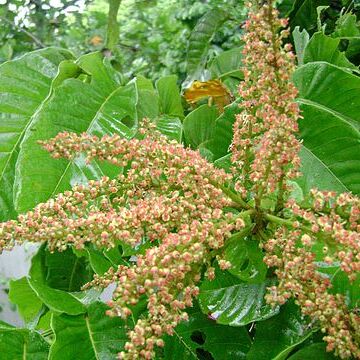Medium-sized to large trees, often buttressed, with a red exudate when cut, monoecious. Indumentum mainly of solitary hairs, sometimes mixed with some small tufts of hairs; no glandular scales. Twigs terete to 5-grooved, lenticels mostly inconspicuous, sometimes warty. Vegetative buds 1 per axil. Leaves spirally arranged, paripinnate, 4-13-jugate; basal leaflets stipule-like, often strongly reduced and caducous; petiole pulvinate, neither petiole nor rachis winged; petiolules broadly attached, nearly always either above with 2 lateral grooves, or with a broad flat groove, or narrowly winged; young leaves crimson, very conspicuous. Leaflets opposite to alternate, lower ones always smaller, beneath not papillose, often with large orbicular glands at least to both sides near the base, often in some to several nerve axils, sometimes scattered over the surface, exceptionally in the marginal incisions; margin entire to dentate. Inflorescences terminal and sometimes in the upper leaf axils, thyrsoid; the branches mostly long, racemiform; cymules short, all of about the same length, patent or nearly so, once dichasial, both branches bostrycoid, condensed, the axes usually partly connate, higher up cymules reduced to 2 seemingly collateral flowers, each bracteate, finally to a single bracteate flower; leaves at base of inflorescence often reduced to mainly the pseudo-stipules; bracts narrowly triangular to filiform, those of primary branches sometimes reduced leaves with 2 or 3 pairs of leaflects; bracteoles absent; pedicels terete, slender, articulated, lengthened and swollen in fruit. Flowers actinomorphic, unisexual. Sepals 5, slightly to more than halfway connate, valvate in bud, the 2 outer ones usually slightly smaller, not petaloid, entire, persistent in fruit. Petals 5 (rarely 0), much shorter to distinctly longer than the calyx, not or hardly clawed, (nearly) entire, without appendages. Disc annular, cushion-shaped, not lobed, ± wavy. Stamens 5 (6), in male flowers long exserted; filaments filiform, hairy mainly in the lower half or glabrous; anthers densely minutely papillose. Pistil sessile; ovary cordate, 2-(or 3-)celled; style about as long as to longer than the ovary. Ovules 1 per ce11. Fruits sessile, mostly only 1 part developed, indehiscent, smooth, glabrous, red to black when ripe; exocarp hard, rather thin; mesocarp rather thick and very juicy, white, semitransparent, tasting sweet, in the dried fruit irregularly split into two fibrous or corky layers, one inside the fruit wall, the other covering the seed. Seeds oblique ovoid, red-brown, fully enveloped by a thin fleshy arillode, hilum orbicular, c. 5 mm diam.
More
Trees, large, monoecious, usually with buttress roots, with red exudate when cut. Leaves paripinnate, alternate, sessile; leaflets usually in many pairs, first pair (near base) small, like stipules, others evidently larger, usually serrate; lateral veins often many, extending to tips of dentate margins, parallel. Thyrses terminal or axillary. Flowers unisexual, actinomorphic. Calyx cupular; sepals half connate, valvate. Petals 5, usually broadly obovate or subtriangular, without scales or with 1 gland adaxially. Disk annular, 5-lobed. Stamens (male flowers) 5, long exserted; filaments glabrous or hairy at base; anthers small. Ovary (female flowers) obcordiform, 2-lobed, 2-loculed, lobes subglobose, glabrous or tomentose; ovules 1 per locule; style filiform, very long, apex twisted. Fruit deeply parted into 2 schizocarps, usually only 1 developed, ellipsoid; pericarp thick, spongy in middle, smooth adaxially. Seeds same shape as schizocarps; testa leathery, seeds fully covered by an aril and adnate to testa; embryo curved.

